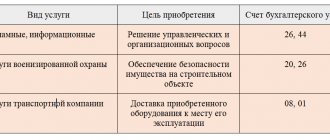Stationary retail chain with trading floors
A stationary trading network with trading floors is a trading network located in buildings and structures (parts thereof) intended for trading, which have separate premises equipped with special equipment intended for conducting retail trade and serving customers.
This category of retail facilities includes shops and pavilions. Stationary retail chain without sales floors
Stationary retail chain
that does not have trading floors is a trading network located in buildings, structures and structures (parts thereof) intended for trading, which do not have separate and specially equipped premises for these purposes, as well as in buildings, structures and structures (parts thereof), used for concluding retail purchase and sale contracts, as well as for conducting auctions.
Understanding the difference in trade objects is necessary for correct registration as a payer of imputed tax, as well as for calculating the UTII tax.
Stationary retail chain facilities
- retail markets
- trade fairs
- kiosks
- tents
- vending machines
Trade establishments can be located
- in separate buildings
- on the first floors of built-in and attached buildings, residential buildings or non-residential buildings
- in the structure (composition) of shopping centers and shopping complexes
What is a shopping complex?
A shopping complex is a collection of trading enterprises that sell a universal range of goods and provide a wide range of services, as well as centralizing the functions of economic services for trading activities.
What is a shopping center?
A shopping center is a collection of trading enterprises and/or service enterprises that sell a universal range of goods and services located in a certain territory.
Brief answers to tax questions
Article 346.43 of the Tax Code provides for the use of a patent taxation system for retail trade in two types of business activities.
This:
- retail trade carried out through stationary retail chain facilities with a sales floor area of no more than 50 square meters for each trade facility;
- retail trade carried out through objects of a stationary trading network that do not have sales floors, as well as through objects of a non-stationary trading network
As defined in the same article:
- a stationary trading network with trading floors is a trading network located in buildings and structures (parts thereof) intended for trading, which have separate premises equipped with special equipment intended for conducting retail trade and serving customers. This category of retail facilities includes shops and pavilions;
- a stationary trading network that does not have trading floors is a trading network located in buildings, structures and structures (parts thereof) intended for trading, which do not have separate and specially equipped premises for these purposes, as well as in buildings, structures and structures (their parts) used for concluding retail purchase and sale contracts, as well as for conducting auctions. This category of retail facilities includes retail markets, fairs, kiosks, tents, vending machines;
- non-stationary trading network - a trading network operating on the principles of delivery and distribution trade, as well as objects of trade organization that are not related to the stationary trading network;
- delivery trade - retail trade carried out outside a stationary retail network using specialized or specially equipped vehicles for trade, as well as mobile equipment used only with the vehicle. This type of trade includes trade using a car, a car shop, a car shop, a toner, a trailer, a mobile vending machine;
- hawker trade - retail trade carried out outside a stationary retail network through direct contact between the seller and the buyer in organizations, in transport, at home or on the street. This type of trade includes trade from hands, trays, baskets and hand carts
As follows from the definitions, very specific categories of retail facilities are listed that do not allow for a broad interpretation. Therefore, if, according to the title documents, the object belongs to a store and pavilion, it is a stationary retail chain with sales floors. For retail markets, fairs, kiosks, tents, vending machines - a stationary retail chain that does not have sales floors.
The Ministry of Finance has the same opinion: “Thus, the list of objects of the stationary retail chain is closed.” (Letter dated August 14, 2012 N 03-11-09/64).
What to do, what activity to obtain a patent for, if an individual entrepreneur plans to carry out retail trade in a building that does not fall into these categories? For example, if the technical passport indicates “non-residential building”.
It should be noted that the answer to this is not straightforward. Because in order to organize trade, an entrepreneur can equip a full-fledged store or pavilion inside the building, as well as install a kiosk or tent. In this case, its object will comply with the definitions of the Tax Code and there will be no difficulties in its classification. To prevent tax disputes, changes should be made to the title documents: “When carrying out retail trade in a rented basement, which, according to the documents (floor plan, explication) is not taken into account as an object intended for trading, in accordance with the provisions of the Regulations on State Technical Accounting and technical inventory in the Russian Federation of capital construction projects, approved by Decree of the Government of the Russian Federation of December 4, 2000 N 921 “On state technical accounting and technical inventory of capital construction projects in the Russian Federation”, an unscheduled technical inventory of accounting objects is carried out in order to identify what happened after the initial technical inventory changes and reflection of these changes in technical passports and other accounting and technical documents.” (Letter of the Ministry of Finance of the Russian Federation dated 04/09/2007 N 03-11-05/65)
A similar approach was demonstrated in the letter of the Federal Tax Service of Russia dated May 27, 2014 N ГД-4-3/ [email protected] “On the direction of clarifications of the Ministry of Finance of Russia”:
“A shopping center is a collection of retail enterprises and/or service enterprises that sell a universal range of goods and services located in a certain territory.
Thus, shopping complexes and shopping centers are a collection of trading enterprises located on the same territory as property complexes that sell a universal range of goods and provide a wide range of services.
Consequently, in relation to the patent taxation system, shopping complexes and shopping centers (in the terminology of the state standard) themselves are not objects of a stationary trading network. In addition, they are not included in the list of stationary retail chain facilities that have trading floors, and stationary retail chain facilities that do not have trading floors, retail trade in which individual entrepreneurs can transfer to a patent taxation system.
At the same time, with regard to business activities in the field of retail trade carried out by individual entrepreneurs through stationary retail chain facilities located in shopping centers and shopping complexes with a sales floor area of no more than 50 square meters for each trade facility (shops and pavilions) and through objects of a stationary trading network that do not have trading floors (retail markets, fairs, kiosks, tents, vending machines), the concepts of which are given in paragraph 3 of Article 346.43 of the Code, a patent taxation system may be applied.
A patent taxation system may also be applied to retail trade carried out through specified retail trade facilities located in shopping centers, shopping complexes, administrative, industrial, educational, etc. buildings, as well as on the territory of retail markets and fairs.”
In other words, if an object is not named in Article 346.43 of the Tax Code as an object of a stationary retail chain, then it is not one. But inside this object there may be a stationary retail chain object.
If none of the above trade objects has been created, then, in our opinion, such a trade organization should be classified as retail trade carried out through a trade organization that is not related to a stationary retail chain.
However, the Ministry of Finance does not consider it acceptable to use the patent system at any non-stationary retail chain facility: “Individual entrepreneurs engaged in retail trade through non-stationary retail chain facilities not listed in paragraph 3 of Article 346.43 of the Code (boxes, containers and other similar retail facilities) located in buildings buildings and structures, does not have the right to apply the patent taxation system" (Letter of the Ministry of Finance of Russia dated May 13, 2014 N 03-11-09/22399).
So, at present the issue does not have a clear solution.
Non-stationary trading network
In accordance with paragraph 3 of Art. 346.43 Tax Code of the Russian Federation non-stationary trading network
a trading network operating on the principles of distribution and peddling trade is recognized, as well as objects of trade organization that are not classified as a stationary trading network.
Distribution trade includes retail trade carried out outside a stationary retail network using specialized or specially equipped vehicles for trade, as well as mobile equipment used only with the vehicle. This type of trade includes trade using a car, a car shop, a car shop, a toner, a trailer, a mobile vending machine.
Retail trade includes retail trade carried out outside a stationary retail network through direct contact between the seller and the buyer in organizations, in transport, at home or on the street.
This type of trade includes trade from hands, trays, baskets and hand carts.
Depending on whether the taxpayer has a sales area or not, when selling retail goods on UTII, the procedure for calculating the single imputed tax as well as the amount of the tax itself will depend.
Object of taxation of trade tax
The trade fee is established in relation to the implementation of trading activities at trading facilities (clauses 1, 2 of Article 413 of the Tax Code of the Russian Federation). Trading activities include the following types of trade:
- trade through facilities of a stationary retail chain that do not have sales floors (with the exception of such facilities that are gas stations);
- trade through objects of a non-stationary trading network;
- trade through stationary retail chain facilities with trading floors;
- trade carried out by releasing goods from a warehouse.
The object of trade is recognized as: a building, structure, premises, stationary or non-stationary retail facility or retail outlet, with the use of which the payer carries out the type of activity in respect of which the fee is established (clause 4 of Article 413 of the Tax Code of the Russian Federation).
Chapter 33 “Trade fee” of the Tax Code of the Russian Federation does not decipher the concepts of “facility of a stationary retail chain”, “facility of a non-stationary retail chain”, “area of a retail facility”.
Officials recommended using the definitions given in Article 2 of the Federal Law of December 28, 2009 No. 381-FZ “On the Fundamentals of State Regulation of Trade Activities in the Russian Federation” (hereinafter referred to as Law No. 381-FZ).
When you don't have to pay a sales tax
The Tax Service has indicated that trading is not subject to tax if the office in which it is carried out:
- does not meet the requirements for a retail facility given in Article 2 of Law No. 381-FZ;
- cannot be recognized as a building, structure, premises or retail outlet.
For example, organizations and individual entrepreneurs engaged in retail or wholesale trade through open areas are not recognized as payers of the trade tax.
At the same time, if temporary structures used for trading are located on an open area, such an open area is a non-stationary trading facility and is subject to a trade tax. This clarification is contained in the letter of the Ministry of Finance of Russia dated October 14, 2015 No. 03-11-09/58630.
The reasoning is similar. Officials pointed out that the concept of a trading facility in the form of an open area, which, according to Article 346.27 of the Tax Code of the Russian Federation, is a place specially equipped for trading, located on a land plot, is not given by Chapter 33 of the Tax Code of the Russian Federation and Law No. 381-FZ.
Bukhgalteriya.ru recommends
Invaluable experience in solving current problems, answers to complex questions, specially selected latest information in the press for accountants and managers. Magazines for accountants and entrepreneurs >>
Most viewed words
- Strategic enterprise (organization)
- Release of products into circulation
- Aircraft emergency
- Engineering support networks
- Public roads
- Legitimacy of the document
- Total floor area
- Mobilization task
- Road maintenance
- Notice of entering a tax return (calculation) in electronic form
- Address certificate
- Information machines and equipment
- Industrial facility
- Crypto tool
- Interdepartmental request
- Production activities
- Production equipment
- Military personnel
- Post-production works
- Descent guide railway track
How to determine the area of a retail space
The Tax Code does not say what the area of a retail space is and how it is determined. According to the Ministry of Finance, when calculating it, it is necessary to take into account not only the area on which the goods are directly sold, but also the area of auxiliary premises (Letters of the Ministry of Finance of Russia dated December 26, 2011 N 03-11-11/320, dated December 22, 2009 N 03-11 -09/410). That is, if you rent a container, part of which you use for selling goods, and the other part as a warehouse, then the tax must be calculated on the entire area of the container (Letter of the Ministry of Finance of Russia dated December 22, 2009 N 03-11-09/410). Last year, this issue was considered by the Supreme Arbitration Court of the Russian Federation (Resolution of the Presidium of the Supreme Arbitration Court of the Russian Federation dated June 14, 2011 N 417/11). Regarding the area of the retail space, the court said that it is determined taking into account all the premises that are used for receiving and storing goods. And since then, there is no more discord in the courts (Resolutions of the Federal Antimonopoly Service of the North Caucasus Region dated August 31, 2011 in case No. A53-22636/2010; FAS Eastern Military District of September 28, 2011 in the case No. A29-1419/2011). But when renting a plot of land on which goods are sold through a small kiosk with an area of more than 5 square meters. m, according to the explanations of the Federal Tax Service, you need to calculate UTII only from the kiosk area (Letter of the Federal Tax Service of Russia dated June 25, 2009 N ShS-22-3 / [email protected] ).
Conclusion It turns out that in some situations it is more profitable for entrepreneurs to insist that they conduct business in a premises with a trading floor. After all, then they will be able to pay tax on a smaller area.
Changes and restrictions on UTII from 2020
Starting in 2021, a number of amendments to tax legislation will come into force.
- The most important thing is the abolition of UTII as a regime in a number of regions as early as 2020, and from January 2021 throughout Russia. We talked in more detail here.
- Prohibition on trade in labeled goods (Article 346.27 of the Tax Code of the Russian Federation):
- fur products - from 01/01/2020;
- shoes - from 03/01/2020 (letter of the Ministry of Finance dated 11/28/2019 No. 03-11-09/92662);
- medications (with the exception of high-cost nosotechnologies - they are labeled starting from 2021) - from 07/01/2020.
The special regime officer will lose the right to use UTII if he sells at least once any product from the list of clause 2 of Art. 346.26 Tax Code of the Russian Federation:
- a car or motorcycle with an engine power of more than 112.5 HP;
- gasoline or diesel fuel;
- products of own production;
- gas;
- drugs on subsidized prescriptions;
- goods outside the retail chain;
- excise goods and products in bars, restaurants and other public catering places - this is not retail, but another type of imputed activity - catering;
- pawn shops for unclaimed items.
ConsultantPlus experts spoke about the specifics of using UTII when selling goods at retail. Get trial access to the system for free and go to the Tax Guide.
Retail zones
A retailer company operates in a trading space common to all, while it is surrounded by its own trading zone, which we will further call the retail zone. In general, this is the territory in which sellers of goods or services and their buyers are located. Professor Huff gives the following definition of a retail zone - “a geographic sector that contains potential consumers who (with a probability greater than zero) can purchase a certain type of product offered to them by trading companies.”
It is generally accepted that the retail zone consists of basic, secondary and peripheral parts. D. Gilbert, in his theory of market area, gives a detailed description of the geographical location of the outlet. He proposes the following definition: a retail zone is the geographic area in which potential customers of an individual retailer are located. The essence of his theory is that inside (in the center) of the market area there is a retail outlet, and around it three zones can be distinguished: basic, secondary, and peripheral.
The difference between these zones is the distance and time required to get to the outlet (store). In works devoted to this issue, it is usually assumed that approximately 60 - 80% of buyers live in the base zone. The radius of this zone is 4-5 km. An important thing for this zone is the fact that within its boundaries there is almost no intersection with the trading areas of competitors. About 15-20% of buyers live in the secondary zone, its radius is 6 - 8 km and within its limits there is less density and slightly greater overlap with competitors’ zones.
The marginal zone includes all other buyers. Usually these are those who are willing to travel a long distance (9-12 km) in order to get to a certain store.
This division is found quite often in the literature, however, with the development of retail, it no longer seems so clearly correct. Even in conditions of a relatively low density of retail chains in Russia by world standards, it is difficult to imagine that within a radius of 4-5 km there would be little overlap with competitors’ zones. In this situation, taking into account the rapid development of the “store at home” format, the following division of retail zones seems more correct [24, p. 71-72]:
— basic – 0.1-1 km, an area in which it is profitable to develop the “convenience store” format. Walking distance or up to 10 minutes drive;
– secondary – 1-5 km. Approximately 10-20 minutes by transport;
- outlying - 5-9 km. Over 20-30 minutes by transport.
Although, in practice, to determine the size of the retail zone , companies usually conduct special studies that take into account the specifics of the format, etc., in the theoretical literature, such a method for determining the retail zone as the Reilly-Converse law is very popular and studied. The idea of this method is to find a point between two shopping areas at which consumers do not care which store they prefer and where to make a purchase, the so-called. point of indifference. The main assumption of this model is that a large object (or in our case a store) attracts more customers than a small one, because it has a wider range of goods, which justifies the increased time spent on shopping.
In addition to external geographical location, internal trading space plays an important role. How the product is accessed and possible sales technologies depend on its characteristics. The two main elements of the internal space for food retailers are: the sales floor and the goods area (warehouse). The sales floor refers to the place where goods are located and the purchase and sale transaction takes place between the seller and buyers. The most important area of research in this area is the pattern of customer movement around the store. Goods area is a place where goods are stored that are not yet displayed for sale on the sales floor. The most important area of research is the optimization of warehouse space and inventory levels. Internal space, and in particular: its size, the way goods are laid out, the level of service, the breadth and depth of the assortment, largely explains the differences between retail formats.
Trading floor or retail space?
This is perhaps the most frequent and most difficult question, as evidenced by the abundance of judicial practice. When can we talk about the presence of a sales area? When a certain place in the room is allocated for buyers, where they can, moving from one shelf with goods to another, become more closely acquainted with the product. Naturally, a retail space cannot have a hall. Usually it is a counter or showcase from which sales are carried out, and buyers can only stand near it and look at the goods displayed. According to the Federal Tax Service, if the title and inventory documents for the premises do not indicate anywhere that this is a “shop” or a “pavilion”, or some part of the premises is not clearly defined as a “trading floor”, then such a premises is considered an object of a stationary retail chain without a trading floor (Letters of the Federal Tax Service of Russia dated 05/06/2010 N ШС-37-3/ [email protected] , dated 07/27/2009 N 3-2-12/83). Some courts even come to the conclusion that the list of objects that may have a sales area is exhaustive, that is, it must be either a store or a pavilion (Resolution of the Federal Antimonopoly Service of the Moscow Region dated August 14, 2009 N KA-A41/6419-09). So, for example, in a former warehouse the presence of a sales area still needs to be proven. And in a container-type pavilion it is a priori, because it is a pavilion (Letter of the Ministry of Finance of Russia dated December 3, 2010 N 03-11-11/310).
For reference, a store is a specially equipped building (part of it) intended for the sale of goods and provision of services to customers and provided with retail, utility, administrative and amenity premises, as well as premises for receiving, storing goods and preparing them for sale. Pavilion is a building that has a sales area and is designed for one or more workplaces (Article 346.27 of the Tax Code of the Russian Federation).
In general, if your retail area does not exceed 5 square meters. m, there is no point in arguing about which physical indicator should be used when calculating tax. After all, the basic profitability when selling goods on the sales floor will be a maximum of 9,000 rubles. (1800 rubles x 5 sq. m), and exactly the same amount is the basic profitability of a retail space (Clause 3 of Article 346.29 of the Tax Code of the Russian Federation). And the hall is less than 5 square meters. m (when taxable income would be less) is difficult to imagine. The K2 coefficients adopted by regional authorities (Clause 4, 7, Article 346.29 of the Tax Code of the Russian Federation) can make their own adjustments, but even taking them into account, the difference in the final tax amounts will most likely be small. If we are talking about an area of more than 5 square meters. m, then the calculation must be carried out based on the area of the retail space or the area of the trading floor, the profitability for which is set to the same - 1800 rubles. per sq. m.
Conclusion If the retail space is large, then it is more profitable to equip it in such a way that you have a trading floor. After all, as we have already noted, when determining the area of a sales floor, the area of auxiliary premises is not taken into account. And for retail places it is taken into account.
If there are auxiliary premises, the court can recognize the trade facility as a store (Resolution of the Federal Antimonopoly Service of the North-West District of January 15, 2010 in case No. A56-36135/2009), which means that there will be a trading floor in this facility. But these should be adjacent premises, and not a separate hangar or room in a neighboring building. A similar case was recently examined by the Supreme Arbitration Court of the Russian Federation. The court indicated that trade was carried out through an object with a sales area, because: - the sublease agreement stated which part of the premises was used as a warehouse, and which part of the premises was sold; — in accordance with the technical passport and explication, the room consisted of two parts; - each part of the area was used for its intended purpose. Consequently, the tax should have been calculated based on the area of the trading floor, and not on the area of the retail space (Resolution of the Presidium of the Supreme Arbitration Court of the Russian Federation dated June 14, 2011 N 417/11). And court decisions made after the release of this Resolution indicate that it has already been adopted by the courts (Resolutions of the Federal Antimonopoly Service of the Eastern Military District dated December 26, 2011 in case No. A79-2716/2010; FAS ZSO dated November 22, 2011 in case No. A45-3709 /2011).
* * *
Despite a fair number of court decisions regarding trading floors and retail places, there are still many questions regarding the calculation of the single tax. The unclear wording of the Tax Code will most likely bring more than one taxpayer to court. But if your retail facility has auxiliary premises, then it is probably more profitable for you to organize trade so that you also have a trading floor. Then you can pay less UTII.
May 2012
Retail trade, UTII
Category: Logistics
Trading enterprise
is a property complex used by an organization for the purchase and sale of goods and the provision of trade services.









